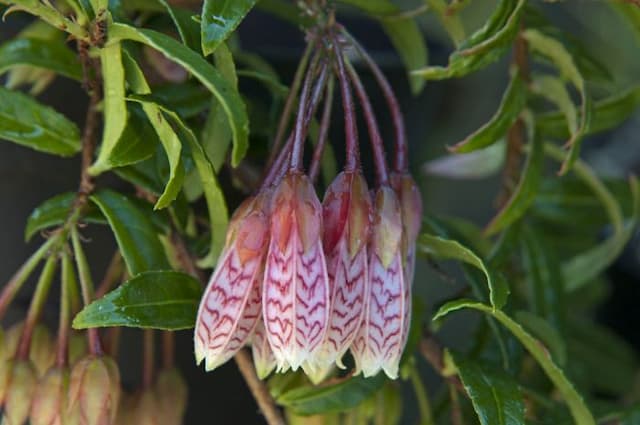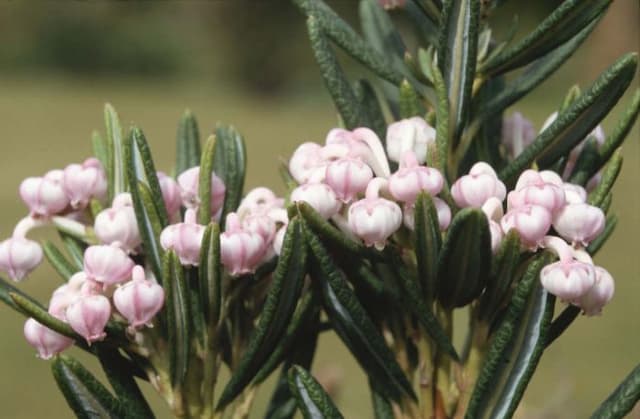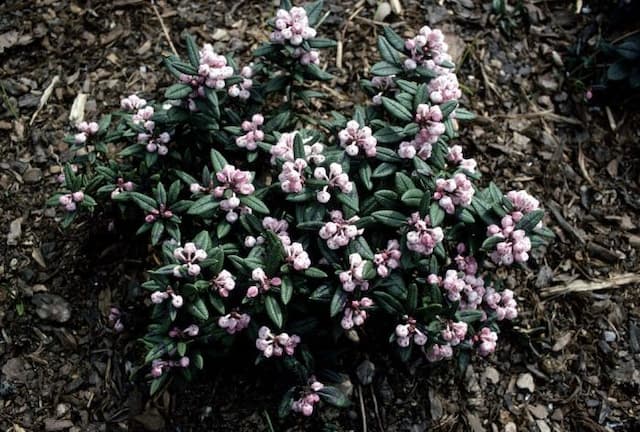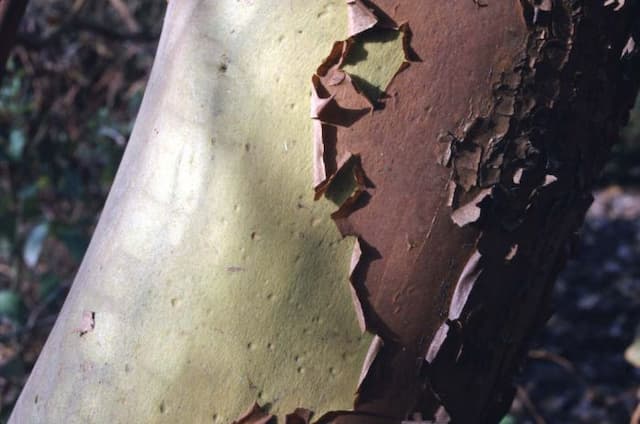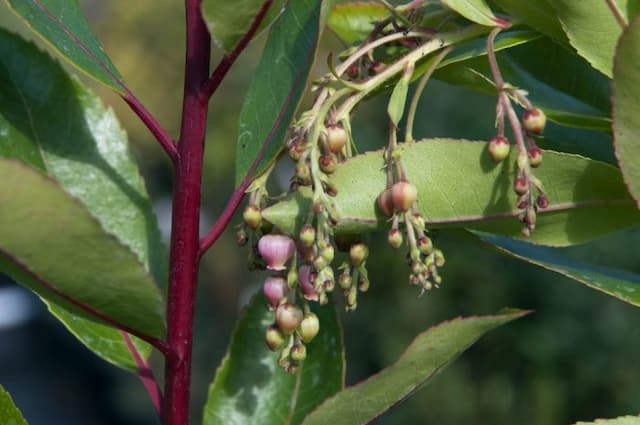Rhododendron 'Corneille' (G/d)

ABOUT
The Rhododendron 'Corneille' is a striking plant known for its lush evergreen foliage and large, vibrant flowers. Its leaves are glossy, dark green, and have a leathery texture that adds to the plant's robust appearance. Come blooming season, this Rhododendron transforms into a spectacle of color with its clusters of showy blossoms. The flowers are known for their trumpet-like shape, with petals that can be a deep, rich pink, often with a hint of purple or violet. Each flower cluster is a striking bouquet, providing a dense, rounded dome of color that contrasts beautifully with the green leaves. The blossoms often have a freckling of deeper color inside that adds to their beauty and gives them a distinct appearance. Overall, the Rhododendron 'Corneille' presents a lush, vibrant display, making it a favorite among garden enthusiasts for its ornamental appeal.
About this plant
 Names
NamesFamily
Ericaceae
Synonyms
Corneille Rhododendron
Common names
Rhododendron 'Corneille'
 Toxicity
ToxicityTo humans
Rhododendrons, including the 'Corneille' cultivar, contain grayanotoxins which are toxic to humans. If any parts of the plant are ingested, symptoms of poisoning can include nausea, vomiting, weakness, dizziness, difficulty breathing, and decreased heart rate. In severe cases, ingestion can lead to coma or even death. It is important to avoid consuming any part of a rhododendron plant.
To pets
The rhododendron plant is also toxic to pets such as dogs and cats. Ingesting even a small amount of the plant can cause symptoms like drooling, vomiting, diarrhea, lethargy, weakness, and potentially, progression to depression of the central nervous system, coma, and death. Immediate veterinary care is crucial if a pet is suspected of having eaten any part of a rhododendron.
 Characteristics
CharacteristicsLife cycle
Perennials
Foliage type
Evergreen
Color of leaves
Green
Flower color
Pink
Height
5 feet [1.5 meters]
Spread
5 feet [1.5 meters]
Plant type
Shrub
Hardiness zones
5
Native area
Asia
Benefits
 General Benefits
General Benefits- Decorative Appeal: The Rhododendron 'Corneille', commonly known as Azalea, is admired for its vibrant flowers which add a splash of color and aesthetic appeal to gardens.
- Landscaping Versatility: Azaleas are commonly used in a variety of landscaping designs, including formal and informal gardens, foundation plantings, and as specimen plants.
- Habitat Support: Azaleas can provide nectar for pollinators such as bees and butterflies, contributing to the local ecosystem's health.
- Seasonal Interest: With a typical blooming time in spring, Azaleas provide seasonal interest and are often a highlight of the garden during this time of year.
- Shade Tolerance: Azaleas are capable of thriving in partial shade conditions, making them suitable for underplanting beneath larger trees or in shaded garden areas.
- Privacy Screening: When planted in groups or rows, Azaleas can form dense shrubs that help to screen views and create private spaces within a landscape.
 Medical Properties
Medical PropertiesThis plant is not used for medical purposes.
 Air-purifying Qualities
Air-purifying QualitiesThis plant is not specifically known for air purifying qualities.
 Other Uses
Other Uses- Rhododendrons can be used as a natural dye. The flowers and leaves of Rhododendron 'Corneille' may yield shades of yellow, green, or brown when used to dye fabric or yarn.
- These plants can serve as a privacy screen. Planting a row of Rhododendron 'Corneille' can create a natural barrier that offers privacy due to their dense growth habit.
- They may be used for bonsai. With careful pruning and cultivation, the Rhododendron 'Corneille' can be shaped into a miniature bonsai tree.
- Rhododendron leaves can be used in compost. The fallen leaves of Rhododendron 'Corneille' can be composted to enrich soil, although they should be composted separately to avoid toxicity in the compost due to their natural compounds.
- They can be a habitat for wildlife. Rhododendrons, including 'Corneille', provide shelter and nesting opportunities for birds and other wildlife.
- The plant serves as a natural insect repellent. The natural compounds in Rhododendron 'Corneille' leaves may deter certain insects from the garden.
- Rhododendron 'Corneille' can be used in soundscaping. The thick, dense foliage can help absorb sound, reducing noise pollution in a garden or landscape setting.
- They are a tool for slope stabilization. The root system of Rhododendron 'Corneille' can help prevent soil erosion on slopes and banks.
- Rhododendrons are used in Feng Shui. The plant is believed to have certain energy properties that can contribute to the positive flow of energy in a garden when placed correctly.
- The flowers can be used in craft projects. Dried Rhododendron 'Corneille' flowers can be incorporated into potpourri, wreaths, or other decorative items.
Interesting Facts
 Feng Shui
Feng ShuiThe Rhododendron is not used in Feng Shui practice.
 Zodiac Sign Compitability
Zodiac Sign CompitabilityThe Rhododendron is not used in astrology practice.
 Plant Symbolism
Plant Symbolism- Beware: Rhododendrons often symbolize caution due to their toxic properties. Ingestion of the plant can be harmful, representing a warning to be heedful.
- Abundance: These plants are known for their lush, vibrant blooms, symbolizing an abundance of beauty or wealth.
- Elegance: With their sophisticated look, rhododendrons are frequently associated with elegance and wealth.
- Escape: Some cultures view the rhododendron as a symbol of escape or a need to find retreat due to the plant's prevalence in remote mountain areas.
- Rebirth: The rhododendron's tendency to have new growth and blooms each season is symbolic of renewal and starting afresh.
 Water
WaterAzaleas, such as Rhododendron 'Corneille', prefer consistently moist but well-drained soil without becoming waterlogged. Water the plant deeply to ensure the root zone is thoroughly moistened, approximately once a week, depending on weather conditions. During the growing season, especially in dry spells, watering may need to be increased to twice per week. Provide about 1 to 1.5 gallons of water per session, ensuring that the water penetrates the soil rather than running off. Reduce watering in the winter months to prevent root rot but do not allow the soil to completely dry out.
 Light
LightAzaleas thrive best in partial shade with some protection from intense afternoon sun. The ideal location for Rhododendron 'Corneille' would be a spot that receives dappled sunlight throughout the day or bright morning light with shade during the hottest part of the day. Avoid deep shade as it can lead to poor blooming and sparse foliage.
 Temperature
TemperatureAzaleas, such as Rhododendron 'Corneille', are generally hardy and can tolerate temperatures as low as 0°F but prefer a range between 50°F and 70°F for optimal growth. They can survive short periods of colder temperatures, but prolonged exposure to temperatures below freezing may damage the plant. The ideal temperature range encourages healthy blooms and foliage growth. Protect the plant from harsh winter winds which can desiccate the leaves.
 Pruning
PruningAzaleas, such as Rhododendron 'Corneille', benefit from pruning to shape the plant, encourage bushy growth, and remove spent flowers or dead branches. Prune azaleas shortly after the blooms fade in late spring or early summer to avoid removing next year's flower buds. It is also a good time to cut back any leggy growth to maintain a compact form. Moderate pruning once annually is typically sufficient.
 Cleaning
CleaningAs needed
 Soil
SoilThe Rhododendron 'Corneille' prefers a soil mix that is well-draining, acidic, and rich in organic matter. A blend of peat moss, pine bark, and perlite can create an ideal environment, with a pH range of 4.5 to 6.0 being best for this azalea.
 Repotting
RepottingAzaleas like the Rhododendron 'Corneille' generally require repotting every 2 to 3 years, or when the roots outgrow the pot. It's best to repot in late winter or early spring before new growth begins.
 Humidity & Misting
Humidity & MistingThe Rhododendron 'Corneille' thrives at higher humidity levels, ideally between 50-60%. It benefits from a moist environment but good air circulation is also important to prevent fungal issues.
 Suitable locations
Suitable locationsIndoor
Place in bright, indirect light and ensure high humidity.
Outdoor
Dappled shade, shelter from winds, acidic mulch, well-drained soil.
Hardiness zone
5-8 USDA.
 Life cycle
Life cycleRhododendron 'Corneille', commonly known as Rhododendron, begins its life as a seed that germinates in well-draining, acidic soil with dappled shade. Upon sprouting, the seedling grows into a young plant, focusing energy on developing a strong root system and foliage. Over several years, this evergreen shrub matures, reaches its full size with a structure consisting of multiple woody stems, and starts producing its characteristic large and often brightly colored flowers in the spring. After pollination, typically by insects, the flowers develop into seed capsules that eventually release seeds to start a new generation. Rhododendrons can also be propagated vegetatively through cuttings or layering, thus skipping the seed stage and ensuring genetic consistency. Throughout its life, this perennial plant will undergo seasonal cycles of growth, flowering, and dormancy, particularly in colder climates, where it prepares for winter by ceasing active growth.
 Propogation
PropogationPropogation time
Spring-Early Summer
The most popular method for propagating the Rhododendron 'Corneille', commonly known as a hybrid rhododendron, is through semi-hardwood cuttings. This involves selecting healthy, semi-mature wood from the current season's growth in the late summer. Cuttings are typically taken from the upper part of the plant, about 4 to 6 inches long, ensuring each has at least two sets of leaves at the top. The lower leaves are removed, and the cut end is dipped in a rooting hormone to encourage root development. The prepared cuttings are then inserted into a mix of peat and perlite, ensuring good contact with the medium. The environment must be kept humid, which is often achieved by covering the cuttings with a plastic dome or using intermittent mist systems. Roots generally form within several weeks, after which the new plants can eventually be potted up individually and grown on before being planted out.
